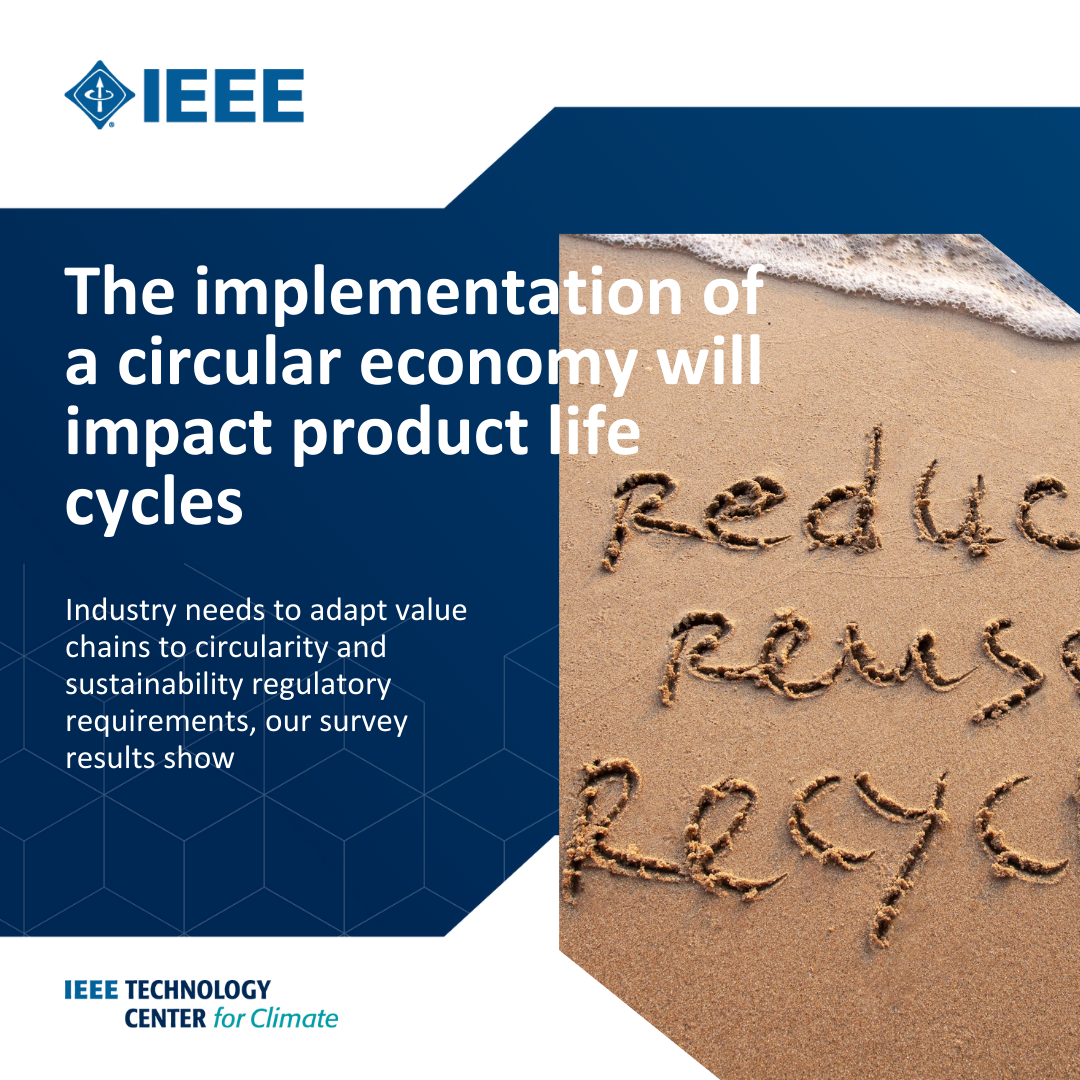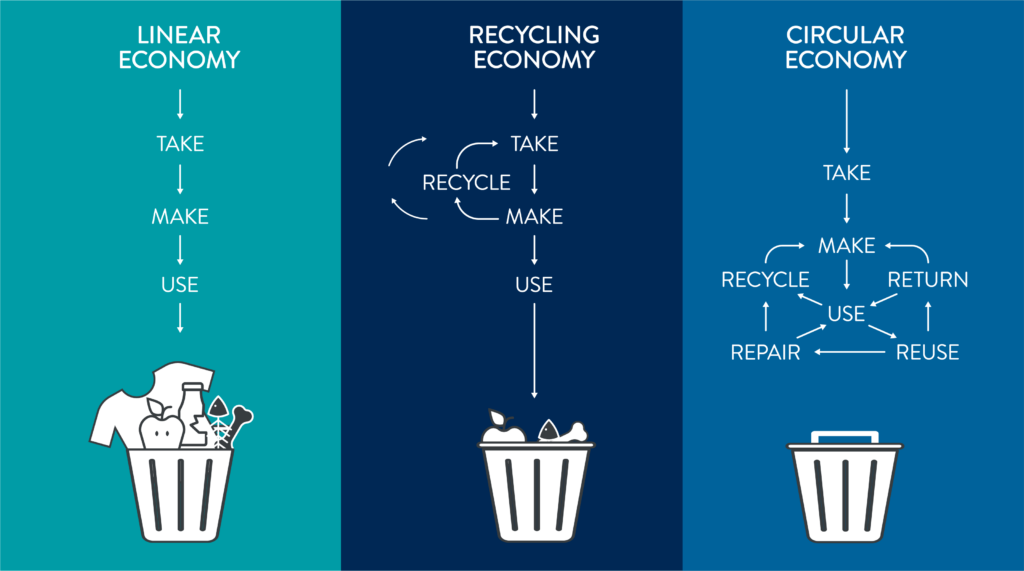Summary
To address climate change, the current linear economic model is not sustainable. It depletes finite resources and creates waste. This forces us to reconsider how our economies are set up, and the potential viability of one in which resources are continually recycled. However, to move from a linear to a circular economy requires a drastic shift in the way value and supply chains are configured. Here’s how and why we should reshape them.
Every year, around 62 million tons of electronic waste (e‑waste) is produced globally, less than a quarter of which is properly recycled. And the waste from electric and electronic devices is only the tip of the iceberg: it is estimated that 2.12 billion tons of waste is produced annually.
Considering the finite resources of the planet, this is not sustainable and it is imperative to move towards a different economic model. Increasing in popularity since the 2010s, the paradigm of a circular economy focuses on retaining the value of resources in our economic system. This impacts inherently the whole product lifecycle, from ideation and design to supply chains.
Closing the loop: the principles of a circular economy
Our current ‘throwaway economy’ operates on a linear trajectory that can be described as “take-make-waste”. Raw materials and resources are extracted, processed into products, used, and then discarded as waste.
Circular economies, in contrast, elimite the concept of waste. The Ellen MacArthur Foundation (EMF) for instance places value preservation at the core of what defines a circular economy; stopping waste and pollution by circulating products and materials at their highest value.
It is a principles-driven system that promotes maintenance, reuse, refurbishment, remanufacture, recycling, and composting. Materials never become waste and nature is regenerated.
Besides waste, current market and consumer behavior further aggravates the environmental impact of our linear economies by incentivising replacement of products on short life cycles. Aligned with the concept of a circular economy, regulations are trying to address these issues with initiatives such as the right to repair or the ecodesign of sustainable products, thus extending the life of products.
While the EMF’s framework provides a widely accepted foundation, there are other interpretations, and a standard definition on the circular economy is under development by the International Organization for Standardization (ISO).
Transforming traditional notions of value and supply
Value chains encompass the sequence of activities that add value to a product, which includes design, production, marketing, distribution and customer support. Supply chains enable the movement of raw materials through processing and assembly into distribution of the finished products.
In a circular economy, it is necessary to move from the chains of traditional product lifecycle and into what we could call ““value and supply networks”. This would mean that value is maintained through the life cycle of a product or process and not lost on disposal. Supply and distribution networks facilitate the recirculation of materials back into the life cycle at the stage for prolonging its use, reuse, remanufacturing or recycling.
“Supply networks rather than supply chains are really important. We have to be very cognizant of the circular economy opportunities at each different stage to be able to make sure that we’re implementing the right one,” said Dr David Greenfield, Vice President, Circular Economy Institute (CEI) on introducing the concept of supply networks during the ITCC webinar the Practical and Scalable Implementation of a Circular Economy.
“I think you can illustrate that if you think about the life cycle of a product and what’s happening to a product in a circular economy”, said Holger Berg, Vice Director of the Circular Economy Division, Wuppertal Institute for Climate, Environment and Energy,
Using the example of a car, he explained how, in a traditional, linear economy, the raw material is iron ore mined to create steel. This is used to manufacture the car, along with the resources used in other parts. At the end of its life, when its value is determined to be lowest, it is discarded as scrap.
While in a circular economy when that same raw material, steel, is used, a car designer considers the aspects of easy disassembly and material reuse during initial manufacturing. Maintenance and repairing are integral parts of a product life both in linear and circular models, although extended life approaches (including extended repairability and availability of spare parts) are at the core of a circular economy.
“Maybe those spare parts go back to the producer to be refurbished or manufactured to be put into another car. So, we already have shortcuts across the circle,” added Berg.
“The same happens when the car itself goes through refurbishment or when recycling starts and we put different materials through different parts of the supply network. So you can see how materials and products start to move around very differently from what we call a linear supply chain,” he finished.
Embedding value and supply networks
The groundwork for the introduction of supply networks for a circular economy is being laid by the introduction of tools that allow companies to track resources and materials. This is the case in both the infrastructure of industries and the products they produce.
Digital product passports are tools that contain information that can be accessed across by all the companies and individuals involved in their production, marketing and distribution, as well as the final consumer, related to sustainability and circularity. This includes information on resource use and recycling. This will be invaluable in ensuring new regulations designed to curb waste, such as the EU bill on battery reuse and recycling, can be enforced.
Similarly, digital materials passports can help construction companies create new buildings from old or discarded materials. They store information about the materials and energy footprint of a building, but also facilitate recovery and reuse of those materials.
To return to the car analogy, the continued growth of the electric vehicle (EV) market is ripe for reshaping as companies will have to comply with the batteries regulations. One potential solution is that when car batteries have outlived their usefulness they can be given a second life as stationary energy storage for homes and businesses.
Further repurposing examples extend from building materials to textiles, and plastics to IT equipment.
However, these networks need to grow and scale up. In Europe, the EU-funded SWITCH programme is designed to support industries moving to a circular economy.
A circular economy for the benefit of people and the planet
A circular economy requires massive change to the way manufacturing, supply and value chains are currently designed and operating.
As Matteo Magnani, Senior Policy Analyst, Ellen MacArthur Foundation said: “It is first and foremost about circulating products. That means making them more durable, making them reusable, implementing different business models that are based on making money out of the reuse of the products.”
Such changes pose significant challenges requiring change management, but if we can put this in place then a thriving circular economy can benefit everyone in a sustainable way for businesses and natural resources.
- We explored how the implementation of value and supply networks are crucial to a circular economy in our recent webinar Practical and Scalable Implementation of a Circular Economy, part of the IEEE webinar series Empowering the Green Tech Revolution: From Design to Deployment. [watch here]
Check the survey we conducted in connection with the webinar “The Practical and Scalable Implementation of a Circular Economy”




Survey
We’d like to hear from you on this topic!
Where do you see the limits and challenges to building a circular economy?
⬇ Let us know below ⬇


